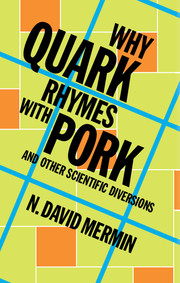Book contents
43 - Writing physics, lecture, Cornell University, 1999
from Part Six - Summing it Up
Published online by Cambridge University Press: 05 January 2016
Summary
One of the questions asked of lecturers in this series is “What first drew you to your discipline?” What first drew me to physics was magic. It came in two varieties: relativity and quantum mechanics. I know that the magic of relativity had grabbed me before I was 16, because I remember my first day of high-school physics in 1951. The teacher was a tight-lipped gentleman who, it was rumored, had risen to the rank of Colonel in World War I. He liked to throw hard rubber erasers at people he thought were dozing.
“Physics,” the Colonel told us, “is about laws that govern the behavior of matter. There is, for example, the law of the Conservation of Mass.” My hand shot up. “Doesn't relativity say that mass is not conserved?” There was a long terrifying silence. “I don't know anything about relativity,” snarled the Colonel at last. “Do you?” I never again inquired about anything not in the textbook: Modern Physics, by Charles E. Dull.
So I must have known something about relativity when I was sixteen. The magic of it was this: If you could move at 99.98% of the speed of light, then in a little over four years you could go four light years, and get to the nearest star. But—here was the magic part—you would be only a month older when you got there. Same thing on the way back. When you got home everybody would be eight years older, but you would have aged only two months. If you did it three or four times you could come back younger than your own kids!
Just as amazing, if on the way out in your spacious mile-long rocket, you passed another one-miler on the homebound run and measured its length as it flashed past, you would find it to be only one foot long, and everybody in it, flattened to the thickness of sheets of paper. And, most mysterious of all, the occupants of the home-bound rocket would find that you and your rocket were correspondingly squashed. How could this be? How could each of two rockets be shorter than the other? I desperately wanted to understand.
- Type
- Chapter
- Information
- Why Quark Rhymes with PorkAnd Other Scientific Diversions, pp. 361 - 375Publisher: Cambridge University PressPrint publication year: 2016



